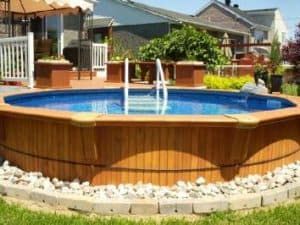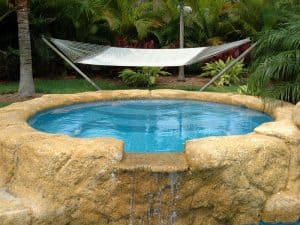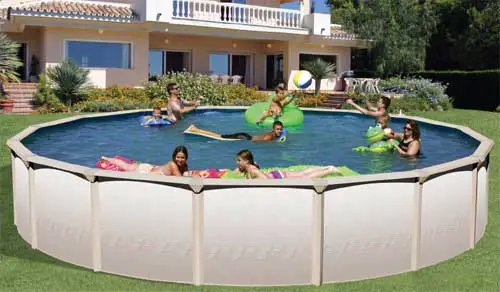A swimming pool is a must have during the Spring and Summer months, especially if your family includes children.
If you don’t have land and financial resources for a larger in ground pool, you can go for the smaller, cheap, and easier to run above ground option.
If you think of an above ground pool but don’t know how to get started with your shopping journey, keep reading.
Eight Manufactured Home Above Ground Pools Shopping Factors
Here are the factors to consider if you want to buy the perfect above ground pool for your family for your manufactured home backyard:
- Type of Pool & Cost
- Shape – Round or Oval?
- Frame Style & Material
- Pump & Filter Systems
- Accessories
- Size
- Depth
- Brand
1. Type of Pool & Cost
Make sure you understand the kinds of pools present on the market.
There are multiple options, and it is smart to evaluate them before you commit to acquire one.
Inflatable Pools
Inflatable pools can be moved from place to place within your backyard and even folded for another installation location.
They are ideal for buyers with small children at home.
The best thing about inflatable pools is that you can deflate and store them safely indoors only to inflate them at the right time.
They may not be the right product for you if you are looking for a deeper, more spacious pool. But the sides tend to be softer, meaning your kids won’t sustain injuries or scraped knees.
The best part is they are easier to set up.
Inflatable pools are not a permanent solution. Animals, weather, and even rough children can damage them.
They are not designed to support sustained usage. As such, they are products you would buy to use once in a while.
Costs
They are the simplest kind of above ground pools out there means they are the cheapest to acquire.
The smaller models start at about $100. Larger models cost anything between $150 to $300.
Pros
Easy tear down, quick install, generally little to zero prep work required, no permanent alterations to your backyard, easy purchase, a slightly inexpensive option
Cons
Hard to keep the water clean for a long time because the kit doesn’t include equipment that is large enough to support huge volumes of water, not designed to be sturdy like other pool options
Traditional Above Ground Outdoor Pools
If you don’t want to spend $30K on a permanent in ground pool but still want something enjoyable and cost effective, above ground pool options come out as the best alternative.
This type of pool is installed permanently over your backyard to give you a deep, year round swimming space without requiring you to dig into the ground.

They are often made with a firm steel structure or resin or both.
Most of the traditional above ground pools you will find in the store can be set up with minimal skill, but it’s recommended you hire a professional installer for the job.
The installation process takes anything between 4 and 6 hours. Much of the work involves levelling out the designated spot.
Costs
They rarely come with fixed price tags, and price points can vary quite considerably.
In most cases, you will need to receive a quote from your supplier, whether local or online.
Depending on the material or size, the prices usually begin at $1,500, and that’s for the kit only.
Pros
A single day is enough for installation, can be easily re located in the event you decide to move, one person (the owner) can easily complete the installation process with limited skill.
A warranty is normally offered on most parts, long term solution – this kind of pools can last 15 to 20 years if well cared for
Pool kits typically starts at about $3,000 if you choose to install it yourself, ladders often come with a disconnect inside the pool for children safety.
Cons
Installation does require some preparation work for your site.
Most of them require a 110V electrical connection to support the filter and pump system.
The vinyl liner can easily leak if it is not well maintained.
Above ground pools doesn’t permit some of the unique water features you normally see with in ground swimming pools (non diving pool = no deep end).
Semi Buried Above Ground Pools
We are not certain you would go this far, but there is a third kind of above ground pool: the semi buried option.
As the name suggests, you will need to sink this pool slightly into the ground, about 2 – 3” feet deep.

After you have sunk the product in the backyard, you will then cover it with bricks, stones, or any other material prescribed by the manual.
You will end up with a sizable above ground pool that resembles an in ground pool but with no major construction work or high price tag involved.
However, not all above ground pools are meant to be set up partially into the ground.
You will need to conduct exhaustive research about specific products to find out if they can be semi buried or would rather be installed in the ground like regular in ground pools.
Costs
Again, you will likely need to request a quote from your supplier to know the exact pricing. However, most of them cost anything in the region of $10,000.
Generally, an above ground pool will cost between $1,700 (if it’s all metal and measures about 18’) and $7,500 if it’s mostly resin and measures about 33’.
You will realize that all metal pools are the least expensive, with all resin options being the most expensive.
If you go for the hybrid pool option, expect to pay anything between what you would pay for resin and metal pool kit.
Pros
Feels and looks very much like in ground pool with a much quicker installation – takes between 3 and 5 days to install depending on site and size, long–term solution, often comes with a warranty.
Cons
Cannot be relocated as easily as inflated pools or traditional above ground pools if you decide to move.
The price tag for this option can be fairly high for some buyers and that’s due to installation, which normally doesn’t support DIY installation.
2. Shape – Round or Oval?
All above ground pools fall in two size categories:
- round
- oval.
Depending on how big your backyard is and what your local ordinances say about above ground pools, either of these two shapes will be appropriate for your needs.
Those who go for oval shaped pools cite their big size because oval pools offer a significantly larger swimming space compared to round pools.
But, again, depending on how big your backyard is, the round pool option may still be the most logical option for you.
For example, the typical 24′ round pool is able to hold more water than the conventional 15′ X 30′ oval option, but you will pay slightly less for the round pool.
The high price tag on oval pools has something to do with the extra parts that are used to hold them together as they are more prone to collapse underwater pressure.
Oval options are good for aesthetics. An oval pool sitting on a deck resembles the traditional in ground pool. Many families choose this look instead of round pools for that reason.
3. Frame Style & Material
The frame of the above ground pool includes top ledges, plates, uprights, and bottom rails.
Virtually all above ground swimming pools are made of resin, steel, aluminium, or combining these two materials.
Steel
Steel walls were highly preferred when above ground pools were starting to be popular.
They are less expensive to use and tend to be heavier than all other materials.
Although technically steel frames are rust resistant, they can oxidize and corrode quickly once exposed to constant salt water and sunlight.
Resin
In most cases, the resin is used to make a single component that serves as part of the larger system, although it is sometimes used to make the entire pool.
The best thing about resin is that it won’t rust, oxidize, or corrode as steel does. But it is more expensive compared to steel.
Resin has a reputation for holding up well to water and other destructive elements. It doesn’t get too hot like steel when left under the sun for a long period.
If you look at these and other benefits, the extra cost on a resin above ground pool is worth every penny of it, especially if durability is a factor for you.
Hybrid
Pools with hybrid frames take advantage of the benefits of both steel and resin.
Typically, the parts more likely to be exposed to moisture are made of resin, while those meant to provide support are made of steel.
However, not all hybrid frames are the same, so be sure to read the specifications to determine which parts are made of which material.
4. Pump & Filter Systems
The filter and pump system is an integral part of any above ground pool.
The filter is responsible for keeping the pool clean and debris free, algae or other substances that may ruin your swimming experience.
The pump, on the other hand, keeps the stream of water circulating.
There exist 3 types of filter/pump systems:
- Sand
- D. E.
- Cartridge
Sand filters
They come with sand which they pump water through to remove dirt.
The water enters the filter, then leaves via tubes located at the tank’s floor (alongside the debris).
D.E. (or Diatomaceous Earth) filter
The filter uses a layer of fossilized diatom exoskeletons to clean the water.
The D.E. powder will “catch” the debris, including any tiny particles that regular sand might miss.
Cartridge filters
They are equipped with cartridges inside them, designed to capture debris as it streams in with water.
They are perfect for low pressure applications and are far more perfect than sand based filters.
Additional Pool Filter Info
It is almost standard for pump and filter systems to come with either 1 speed or 2 speeds.
There are no specific recommendations on which speed should be used where. This means you can use either speed in any above ground pool.
Pricewise, 2 speed pumps are the costliest option.
Also, the 2 speed option simply permits the flexibility of low and high settings, allowing your pump to remain running for 24 hours on low, and ensures some energy efficiency.
Most of the pump options you will have in the store fall between 0.5 HP pumps and 2 HP.
The filter size choice mainly depends on pool size – commonly used sizes are 100#, and 300# and 400# filters (sand).
Your pool supplier will generally have the standard pump ready for you, which can work with their pool kit.
You can always upgrade to a different pump you prefer for your pool. Most pools don’t upgrade for the sand filter – it is strictly based on your pool’s size.
Depending on your retailer, you may have the option to upgrade the filter media that is used in your filter. Sand is common, but there are other options, such as glass filter media.
5. Accessories
You will need to check if the pool kit of your liking comes with some of these accessories.
Some of them can be purchased separately.
Remember to ask the supplier which is included in the kit and which isn’t. They include, but not limited to:
Heaters
Heaters permit your family to begin swimming a season earlier or extend it.
So, if you are looking for a pool that will allow you to enjoy comfortable water temperatures around the year, choose one with a heater.
The heater will also increase the efficacy and value of the pool. You might want to buy this part separately.
Cleaners
Automatic swimming pool cleaners helps keep the water sparkling clean.
They will vacuum everything from large leaves to microscopic dust and ease the maintenance work.
Salt Systems
A salt system is a must have if you want to have a nice time with your pool.
They reduce the amount of time spent on cleaning the pool. Salt systems are a better alternative to conventional chlorine for buyers with sensitive skin.
Lights
Lighting around and inside your pool offers ambiance and safety
Solar Covers
Covers helps keep your water clean at all times and even retain heat when you are not using the pool.
6. Size
The first thing to consider here is your backyard’s size and whether enough room will be left for the backyard after you have put most of it to use.
Also, consider the space left for playing (kids want to run around and leap into the pool)
Another thing – make sure you read and understand local ordinances and rules set by your HOA regarding the installation of a swimming pool.
Also, seek installation guidance if you have utility lines running beneath your backyard.
You will need to avoid some areas, especially those that provide passage to your utility lines, or, even better, move these obstructions. You also need to avoid overhead power lines.
So what size of above ground pool would be perfect for your home?
This kind of pool is seldom as large as traditional in ground pools.
Consider the number of users. If you are a family of, say, 4 individuals, or you are buying it for your 3 kids, you will want a sizable pool. The larger the number of users, the larger the size of the pool.
Once you have made up your mind about the installation area plus the number of users, you can decide the largest pool size that will fit.
Above ground pools typically come in these sizes (diameter): 12’, 15’, and 18’ – small, 21’, 24’, and 27’ – midsize, 30’ and 33’ – large. You can go for oval sizes if the area of installation won’t permit round pools.
The steps between different sizes of pools can be big, you can consult these tables:
Round Pools
| Pool Size | Number Of Swimmers |
|---|---|
| 15’ | 1 – 2 |
| 18’ | 2 – 3 |
| 21’ | 3 – 4 |
| 24’ | 4 – 5 |
| 27’ | 5 – 6 |
| 30’ | 6 – 8 |
| 33’ | 9 or more |
Oval Pools
| Pool Size | Number Of Swimmers |
|---|---|
| 12’ X 24’ | 1 – 2 |
| 15’ X 25’ | 2 – 3 |
| 15’ X 30' | 3 – 4 |
| 16’ X 32’ | 4 – 5 |
| 18’ X 33’ | 5 – 6 |
| 18’ X 36’ | 6 – 8 |
| 21’ X 41’ | 9 or more |
7. Depth
With all other factors considered, how deep do you want your pool to be?
Most of the above ground pools you will find at the dealer’s place comes with 48″, 52″, or 54″ walls (or something in that region), with the 54″ wall being the tallest.
Sizes do vary between models. The higher the wall (or, the deeper the pool), the more gallons it will hold.
Again, you will need to consider the intended users.
Some families buy this kind of pool for their small children and prefer short wall sizes.
Then some like to establish a “deep end” spot in their pools and would therefore go the tallest wall.
Everything boils down to personal preferences and needs.
8. Brand
The above factors are enough to get you a decent product, but a pool from Namco, Sharkline, Atlantic Pools, Aqua Leader, Doughboy Pools, Embassy, FitMass Pools, and Intex would be quality.
Conclusion
To get the best above ground pool, bear in mind the type of pool and cost, shape – round or oval?
Frame style and material, pump and filter systems, accessories, size, depth, and brand.

